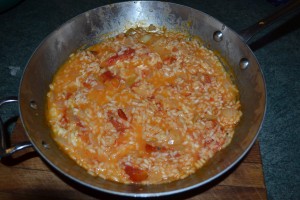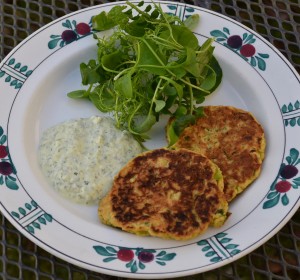In her latest blog on seasonal food, Alicia Miller explains how they bring a taste of summer to their plates in late January…
As we packed our Christmas vegetable boxes a few weeks back, it was apparent that the rootiest time of year was upon us – potatoes, carrots, parsnips, beets, swedes and celeriac are the staples of holiday meals. We always green our boxes out a bit with winter salads, leeks and ample greens. A lot of people have a difficult time with seasonal eating in the winter – even much loved roots can feel a bit unrelenting by February. It’s tempting to succumb and buy out of season tomatoes flown in from abroad.
A better way of staying seasonal while still having a bit of that Mediterranean veg we all love so much is to process things in the autumn as they go off. When the last of our summer tomatoes are about to be ripped out, we try to clear whatever we can off the vines. These are generally the overripe and slightly dodgy ones that have a few moldy bits here and there. The best and easiest thing to do is roast them with whatever fresh herbs you have to hand. I just cut the tops off, arrange them in a roasting pan, drizzle with lots of olive oil, salt, pepper and some herbs (oregano and thyme are always good). Roast at 200c for about 40 – 50 minutes depending on size and then leave to cool. The only fiddly part is getting the skins off – they slip off easily but you’ve still got to do each tomato. Then we just freeze them in a container with all the herbs and seasoning (though picking out any twiggy bits is always a good idea).
 A few months later in the dark depths of winter you can then whip these out for a quick meal. I recently cooked up a favourite Hugh Fearnley-Whittingstall recipe using my lovely tomatoes, his ‘Tomato and Mozzerella Risotto’, from River Cottage Veg Everyday – a cookbook you can’t live without if you’ve devoted your life to growing veg. Making risotto is really easy but it does take a bit of time tending it. Saute an onion or two in a mix of olive oil and butter until it’s softened. Then add your risotto (2 cups will make enough for 4 – 5 people) and saute for another minute. Then add a cup of white wine and cook on medium-low heat stirring until the wine is absorbed and the risotto is starting to stick a bit on the bottom. After that you start adding stock – I generally just use a good vegetable stock like Marigold for the sake of time and this is comfort food so you don’t have to be precious about it. I pour enough in to just cover the risotto and let it cook for a few minutes without stirring. As the rice starts to absorb the stock, I stir it a bit to make sure it’s not sticking. If you have problems with it sticking too much, turn your heat down.
A few months later in the dark depths of winter you can then whip these out for a quick meal. I recently cooked up a favourite Hugh Fearnley-Whittingstall recipe using my lovely tomatoes, his ‘Tomato and Mozzerella Risotto’, from River Cottage Veg Everyday – a cookbook you can’t live without if you’ve devoted your life to growing veg. Making risotto is really easy but it does take a bit of time tending it. Saute an onion or two in a mix of olive oil and butter until it’s softened. Then add your risotto (2 cups will make enough for 4 – 5 people) and saute for another minute. Then add a cup of white wine and cook on medium-low heat stirring until the wine is absorbed and the risotto is starting to stick a bit on the bottom. After that you start adding stock – I generally just use a good vegetable stock like Marigold for the sake of time and this is comfort food so you don’t have to be precious about it. I pour enough in to just cover the risotto and let it cook for a few minutes without stirring. As the rice starts to absorb the stock, I stir it a bit to make sure it’s not sticking. If you have problems with it sticking too much, turn your heat down.
When most of the stock is absorbed, I add more stock and do the same thing again. The rice cooks slowly through this process and gets creamier as you go. Much is made of not overcooking risotto but I find that most people actually undercook it as a result. Ideally, it should not have any crunch in it, but neither should it be soft and sloppy in your mouth – you want to be able to feel the grains. When the rice is almost there, cook off the stock and then add your roasted tomatoes and cook the rest of the way – it should only be a few more minutes. You can add a little more stock if the risotto doesn’t have enough moisture, as it should be nice and loose, but not like soup. The final kicker comes when you break mozzerella pieces and add them into the rice, allowing them to melt a bit. Season the risotto well and top with ample parmesan.
 My other winter respite, when I want something light and Mediterranean in style, is leeks. I like to make fritters out of them – Yotam Ottolenghi, another great veg chef, has an excellent and foolproof recipe that I use a lot. I’ve not had great luck with fritter recipes, which can often turn out soggy, but this is a good one. The sauce works well with just parsley which we still have in our polytunnels, though it’s getting a bit ropey. If you’ve not got that, a salty, garlicky yoghurt-based sauce with a bit of cumin, paprika and ground coriander would work well. Leeks also make a delicious risotto; just use in ample amounts instead of onions.
My other winter respite, when I want something light and Mediterranean in style, is leeks. I like to make fritters out of them – Yotam Ottolenghi, another great veg chef, has an excellent and foolproof recipe that I use a lot. I’ve not had great luck with fritter recipes, which can often turn out soggy, but this is a good one. The sauce works well with just parsley which we still have in our polytunnels, though it’s getting a bit ropey. If you’ve not got that, a salty, garlicky yoghurt-based sauce with a bit of cumin, paprika and ground coriander would work well. Leeks also make a delicious risotto; just use in ample amounts instead of onions.
Along with root vegetables, brassicas are a big family of winter veg – cabbage, kale, cauliflower, purple sprouting broccoli, Brussels sprouts and others bring that bit of green to our roots. Roots and brassicas are perfectly suited to one another, whether you are making Bubble and Squeak or adding complements to your hearty stew.
One winter favourite on the farm are the shoots which we take as a secondary crop off our cabbages and kales. We’ve discovered these baby shoots are as deliciously edible as the main crop, they’re just small. We cut these and put them in mixed bags which are beautiful in their diversity with different miniature cabbage and kale shoots. They cook quickly, sautéed with a little onion and cream. I start with the onion, cooking it with a bit of salt until it softens; then add the shoots and soften them a bit, finally adding a bit of water and covering for few minutes until they are tender. Take the lid off the pan and continue cooking until the water has evaporated. Splash a bit of cream in and cook, stirring until the cream has thickened and coated the shoots. Then season with more salt and pepper. You don’t have to have the cream bit in the shoots but it does make it oh so much more luxurious.
Alicia
About Troed Y Rhiw Farm
A small family-run organic farm on the beautiful West Wales Coast, they grow 12 acres of mixed vegetables and soft fruit and also run courses in beekeeping and organic growing. For more information about this and their lovely holiday cottages see www.troedrhiwfarm.co.cuk or email info@troedrhiwfarm.co.uk.
